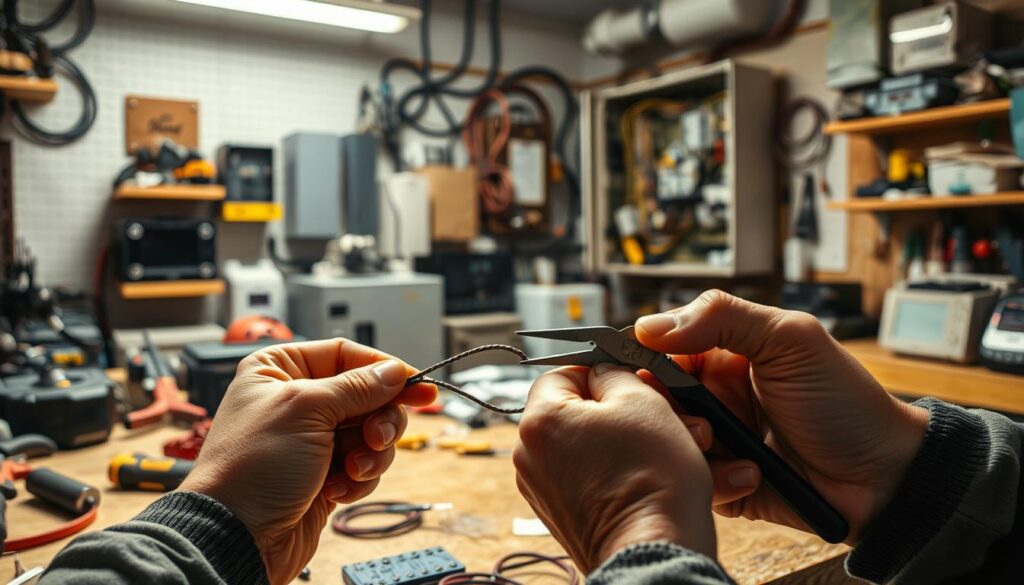Have you ever experienced a sudden power outage or flickering lights in your home? It’s frustrating and can be a sign of underlying electrical issues that need to be addressed. Many homeowners face common electrical problems, such as dead outlets, tripped circuit breakers, or buzzing switches, and often don’t know how to fix them.
Fortunately, with some DIY electrical repair tips, you can easily identify and fix these issues. By learning basic electrical repairs, you can save time and money, and ensure your home remains safe and functional.
Key Takeaways
- Identify common electrical problems in your home
- Learn DIY electrical repair tips for simple fixes
- Understand when to call a professional for complex issues
- Essential tools needed for electrical repairs
- Steps to take for safe and effective electrical repairs
Understanding Basic Electrical Systems
Grasping the fundamentals of your home’s electrical system is crucial for maintaining electrical safety and performing effective home electrical maintenance. A basic understanding can help you identify potential issues before they become major problems.
Components of a Home Electrical System
A typical home electrical system consists of several key components. These include the electrical panel, circuit breakers or fuses, wiring, outlets, and lighting fixtures. Each of these components plays a vital role in the safe distribution of electricity throughout your home.
- Electrical Panel: The main hub of your electrical system, where the power from the grid is distributed to various circuits.
- Circuit Breakers or Fuses: Safety devices designed to interrupt the flow of electricity in case of an overload or short circuit.
- Wiring: The network of cables that carry electricity from the electrical panel to various parts of your home.
- Outlets and Lighting Fixtures: The endpoints of your electrical system, providing power for appliances and lighting.
How Electricity Flows in Your Home
Electricity flows into your home through the main electrical service lines, passing through the electrical meter and into the electrical panel. From there, it’s distributed to various circuits, which supply power to different areas of your home. Understanding this flow is essential for electrical safety for beginners, as it helps in identifying where issues might arise.
“The electrical system in a home is like a network of roads for electricity. Understanding how it works is crucial for maintaining safety and efficiency.”
To illustrate how electricity is distributed, consider the following table:
| Component | Function | Safety Consideration |
|---|---|---|
| Electrical Panel | Distributes power to circuits | Ensure proper grounding and secure connections |
| Circuit Breakers | Interrupt power in case of overload | Regularly test to ensure they’re functioning correctly |
| Wiring | Carries electricity throughout the home | Avoid damage during renovations or repairs |
By understanding the components of your home electrical system and how electricity flows, you’re better equipped to perform basic home electrical maintenance and ensure electrical safety for beginners. This knowledge is the first step towards a safer and more efficient home electrical system.
Safety First: Electrical Repair Precautions
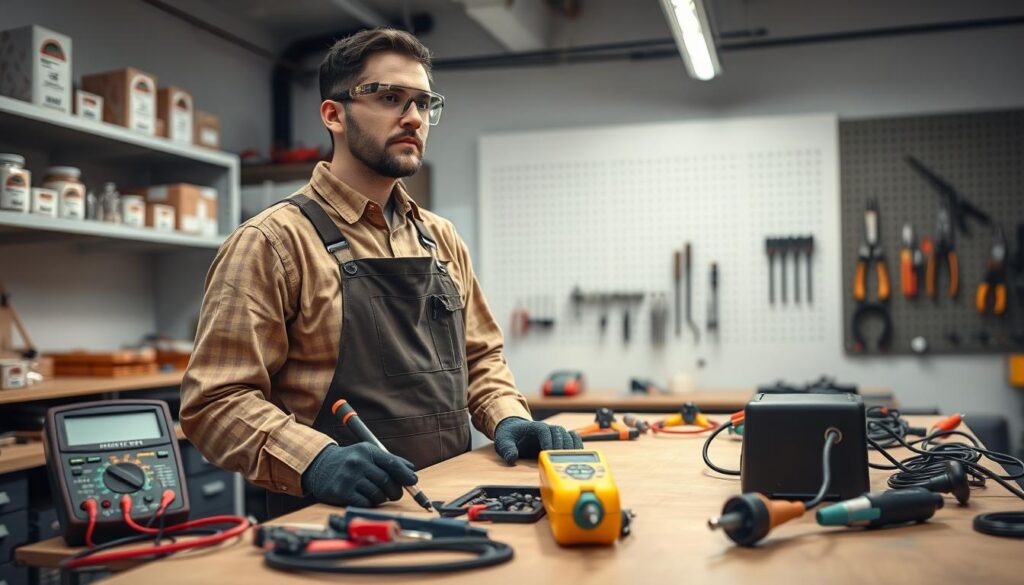
When tackling common electrical problems at home, safety should always be your top priority. Electrical repairs can be hazardous if you’re not properly prepared. Ensuring your safety involves understanding the basics of electrical systems and taking necessary precautions.
Importance of Turning Off Power
Before starting any electrical repair, it’s crucial to turn off the power to the circuit or device you’re working on. This can be done by switching off the relevant circuit breaker or removing the fuse. Verify that the power is off using a voltage tester to avoid electrical shock.
- Locate your home’s main electrical panel.
- Identify the correct circuit breaker or fuse for the area you’re working on.
- Switch off the breaker or remove the fuse.
Using Proper Personal Protective Equipment
Using the right personal protective equipment (PPE) is vital when performing electrical repairs. This includes:
- Insulated gloves to prevent electrical shock.
- Safety glasses to protect your eyes from debris.
- A hard hat if you’re working in an area with overhead hazards.
By turning off the power and using proper PPE, you significantly reduce the risk of injury when troubleshooting home electrical issues. Remember, safety should always be your first consideration.
Identifying Common Electrical Problems
Identifying common electrical problems is the first step towards resolving them effectively. Homeowners can encounter a variety of electrical issues, ranging from minor inconveniences to significant safety risks. Being aware of these problems and knowing how to troubleshoot them can save time and prevent potential hazards.
Flickering Lights: Common Causes
Flickering lights can be caused by several factors, including loose bulb connections, faulty light fixtures, or issues with the electrical circuit. To address flickering lights, start by checking the bulb connection. Ensure it is screwed in tightly and not loose.
- Inspect the bulb for signs of wear or damage.
- Check the light fixture for any signs of damage or wear.
- Verify that the issue is not with the circuit by checking other lights on the same circuit.
According to a study, “Flickering lights are not just an annoyance; they can be a sign of a more significant electrical issue that needs to be addressed.”
“Flickering lights can indicate a variety of problems, from simple issues like loose bulbs to more complex electrical faults.” – Electrical Safety Foundation
Dead Outlets: Troubleshooting Tips
Dead outlets can be frustrating and are often caused by tripped circuit breakers or faulty outlet wiring. To troubleshoot dead outlets, follow these steps:
- Check the circuit breaker panel to see if a breaker has tripped.
- Test the outlet with a multimeter to determine if it is receiving power.
- Inspect the outlet for any signs of damage or wear.
| Issue | Possible Cause | Troubleshooting Step |
|---|---|---|
| Flickering Lights | Loose Bulb Connection | Tighten the bulb connection |
| Dead Outlets | Tripped Circuit Breaker | Check and reset the circuit breaker |
For homeowners attempting to fix electrical issues, having the right electrical repair tools is crucial. Easy electrical fixes for beginners often involve simple troubleshooting steps like those outlined above.
Simple Solutions for Flickering Lights
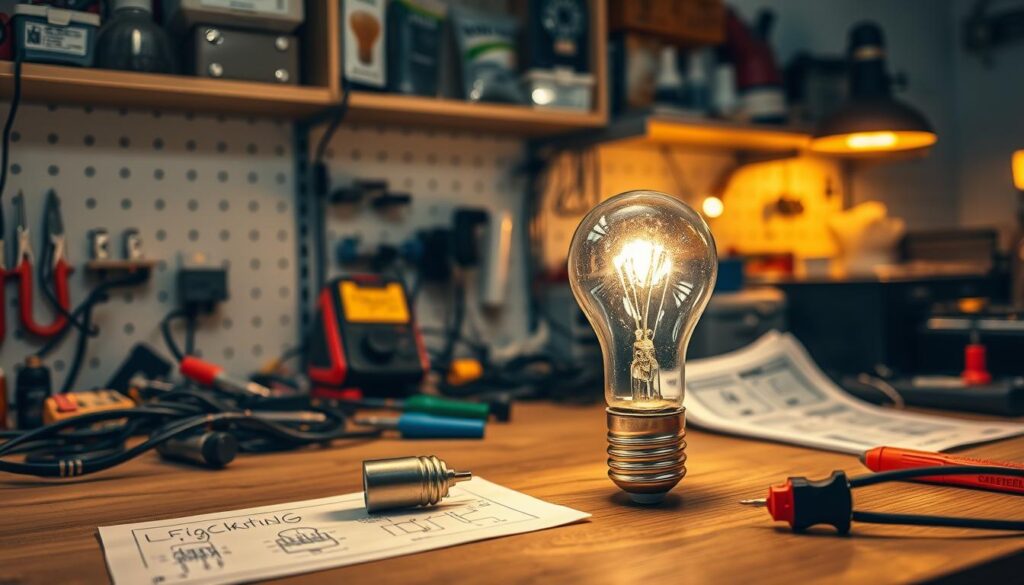
One of the most common electrical issues homeowners face is flickering lights, which can be addressed with some straightforward fixes. Flickering lights are not just annoying; they can also be a sign of an underlying electrical issue.
Checking Bulb Connections
A loose bulb connection is a common cause of flickering lights. To check the connection, turn off the power to the light fixture at the circuit breaker or fuse box. Then, remove the bulb and inspect the socket for any signs of wear or corrosion. Re-seat the bulb firmly, ensuring it’s screwed in properly. If the bulb is loose, tightening it may resolve the issue.
Inspecting Light Fixtures
If checking the bulb connection doesn’t solve the problem, the issue might lie with the light fixture itself. Inspect the fixture for any signs of damage or wear. Look for loose or corroded connections within the fixture. Cleaning the fixture can sometimes resolve the issue, especially if there’s a buildup of dust or debris affecting the electrical connection.
As noted by electrical experts, “Flickering lights can be a sign of a more significant electrical problem. If simple fixes don’t work, it’s crucial to investigate further to prevent potential hazards.”
- Check for loose wiring or connections within the fixture.
- Inspect the fixture’s electrical components for signs of wear or damage.
- Consider replacing the fixture if it’s old or damaged beyond repair.
By following these simple solutions, homeowners can often resolve flickering light issues on their own. However, if the problem persists, it may be a sign of a more complex electrical issue that requires professional attention.
Repairing Dead Outlets
Fixing dead outlets is a straightforward process that can be accomplished with the right tools and knowledge. Home electrical maintenance is crucial for ensuring the safety and efficiency of your home’s electrical system. One common issue homeowners face is dead outlets, which can be caused by a variety of factors.
Testing with a Multimeter
To diagnose a dead outlet, you’ll need a multimeter. This handy tool measures voltage, current, and resistance, helping you identify if the outlet is receiving power. For electrical safety for beginners, it’s essential to understand how to use a multimeter correctly. Set the multimeter to the voltage setting (usually denoted by a ‘V’ symbol), and carefully insert the probes into the outlet’s slots. If the multimeter reads zero or very low voltage, it indicates the outlet is not receiving power.
For a more detailed guide on fixing common electrical issues, you can refer to this handyman guide, which provides comprehensive tips and safety precautions.
Replacing Outlet Covers
Sometimes, the issue with a dead outlet might be as simple as a faulty outlet cover. Replacing an outlet cover is a simple task that can often resolve the problem. First, ensure the power to the outlet is turned off at the circuit breaker or fuse box. Then, remove the screws holding the cover in place, and gently pull the cover away from the outlet. Inspect the cover for any signs of damage or wear. If it’s damaged, replace it with a new cover, making sure it’s securely fastened.
“Electrical safety is not just about fixing problems; it’s about preventing them. Regular maintenance can help identify potential issues before they become major hazards.” – Electrical Safety Foundation
Here is a comparison table summarizing the steps for testing and replacing outlet covers:
| Step | Testing with Multimeter | Replacing Outlet Covers |
|---|---|---|
| 1 | Set multimeter to voltage setting | Turn off power at circuit breaker |
| 2 | Insert probes into outlet slots | Remove screws holding cover |
| 3 | Read voltage on multimeter | Inspect cover for damage |
| 4 | Diagnose issue based on reading | Replace cover if necessary |
By following these steps and maintaining your home’s electrical system, you can ensure a safer and more efficient home environment.
Fixing Tripped Circuit Breakers
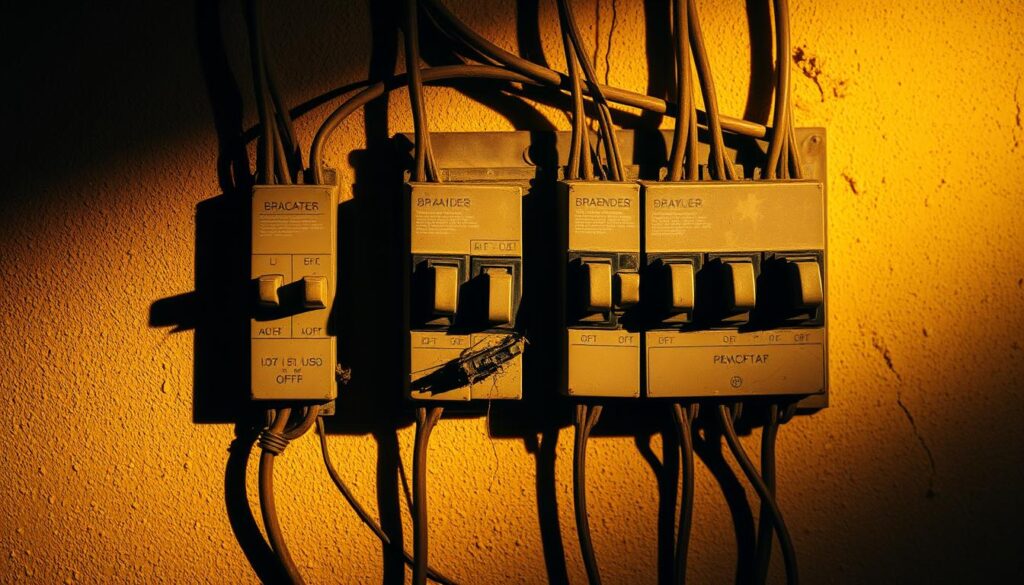
Understanding how to fix tripped circuit breakers is essential for homeowners to maintain electrical safety and efficiency. Circuit breakers are critical components of your home’s electrical system, designed to prevent damage from overloads and short circuits.
Understanding Circuit Breaker Function
Circuit breakers act as automatic switches that interrupt the electrical circuit when an overload or short circuit is detected. This function protects your home’s wiring and appliances from potential damage. Regular maintenance and understanding how circuit breakers work can help prevent common electrical problems at home.
Steps to Reset a Tripped Breaker
Resetting a tripped circuit breaker involves a few straightforward steps:
- Identify the tripped breaker by checking your circuit breaker panel. The switch will typically be in a middle or “tripped” position.
- Turn the breaker switch to the “off” position. This ensures the circuit is completely de-energized.
- After a few minutes, switch the breaker back to the “on” position. This allows the breaker to reset.
- If the breaker trips again immediately, it may indicate a more serious electrical issue that requires professional attention.
Troubleshooting home electrical issues like tripped circuit breakers can be straightforward when you understand the basics. However, if problems persist, it’s crucial to seek help from a licensed electrician to ensure your home remains safe and compliant with local electrical codes.
Addressing Overloaded Circuits
Overloaded electrical circuits are not just a nuisance; they can be a serious safety hazard if not properly managed. Homeowners often face this issue due to the increasing number of devices and appliances being used simultaneously.
Signs of Overload
Recognizing the signs of an overloaded circuit is crucial for preventing potential electrical fires or damage. Common indicators include:
- Frequently tripped circuit breakers or blown fuses
- Dimming or flickering lights when using multiple appliances
- Warm or discolored outlets
- A burning smell from outlets or appliances
For a more detailed guide on detecting and fixing overloaded circuits, you can visit this resource for comprehensive information.
Redistributing Electrical Loads
To address overloaded circuits, homeowners can take several steps to redistribute the electrical load more evenly. This can involve:
- Unplugging non-essential devices from overloaded circuits
- Distributing high-power appliances across different circuits
- Using electrical repair tools for homeowners to inspect and manage circuit loads effectively
By taking these steps, homeowners can significantly reduce the risk associated with overloaded circuits and ensure a safer, more efficient electrical system.
Replacing Light Switches
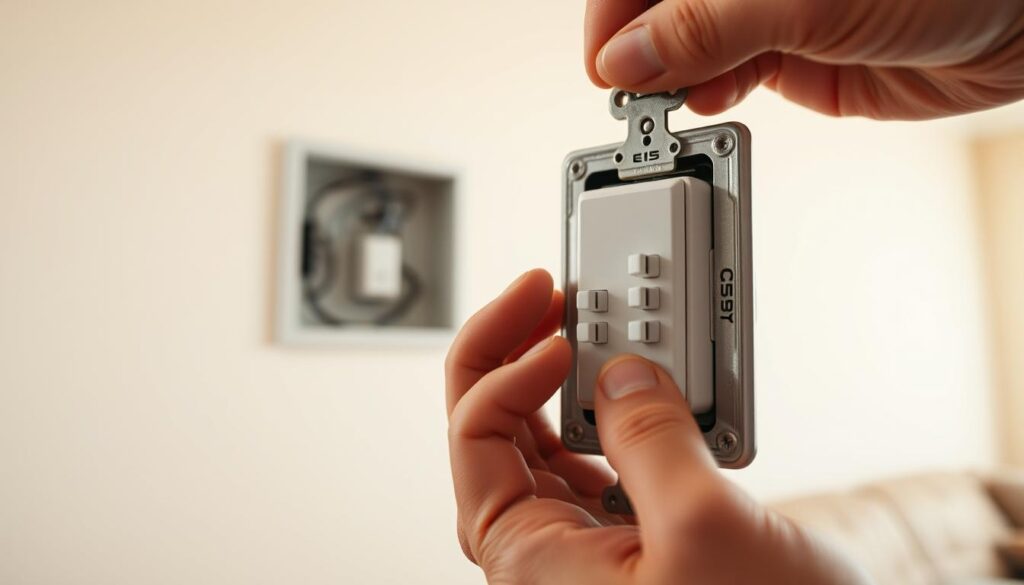
For homeowners looking to tackle simple electrical repairs, replacing a light switch is a great starting point. This task is an easy electrical fix for beginners and can significantly improve the functionality and safety of your home’s electrical system.
Before you begin, it’s essential to understand that replacing a light switch involves a few straightforward steps. By following this guide, you’ll be able to complete the task efficiently and safely.
Tools You’ll Need
To replace a light switch, you’ll need a few basic tools. These include:
- A screwdriver (preferably a Phillips head)
- Needle-nose pliers
- A voltage tester
- The new light switch
Having these tools on hand will make the process smoother and ensure you can complete the task without unnecessary delays.
Step-by-Step Replacement Guide
Replacing a light switch can be broken down into several manageable steps:
- Turn off the power: Ensure the power to the circuit is turned off at the main electrical panel. Verify this using a voltage tester.
- Remove the faceplate: Take out the screws holding the faceplate in place and gently pull it away from the wall.
- Disconnect the old switch: Carefully disconnect the wires from the old switch. Note the color coding of the wires for reference.
- Connect the new switch: Connect the wires to the new switch, matching the color coding. Secure the connections tightly.
- Replace the faceplate: Put the faceplate back in place and secure it with screws.
- Turn the power back on: Restore power at the electrical panel and test the new switch.
By following these steps, you’ll be able to replace your light switch efficiently. This DIY electrical repair tip is a valuable skill for any homeowner, enhancing both safety and convenience in your home.
Handling Faulty Ceiling Fans
Faulty ceiling fans can be a nuisance, but fortunately, many issues can be resolved with simple troubleshooting. Ensuring your ceiling fan operates smoothly is a crucial aspect of home electrical maintenance. Regular checks can help prevent minor issues from becoming major problems, enhancing overall electrical safety for beginners and experienced homeowners alike.
Common Issues with Ceiling Fans
Ceiling fans can experience a range of issues, from simple problems like loose screws to more complex electrical faults. Some common problems include:
- Unusual noises
- Flickering or dim lighting
- Failure to turn on or off
- Wobbling or uneven rotation
For more detailed information on fixing common ceiling fan problems, you can visit this resource.
Troubleshooting Techniques
Troubleshooting your ceiling fan involves a systematic approach to identifying and resolving the issue. Start by checking the power supply and ensuring the fan is properly assembled. For more complex issues, consulting a professional might be necessary, especially if you’re not familiar with basic electrical safety for beginners. In cases of emergency or complex electrical issues, consider reaching out to an emergency contractor services for assistance.
As emphasized by electrical safety experts, “Regular maintenance is key to preventing electrical hazards.” Ensuring your ceiling fan is well-maintained not only prolongs its lifespan but also contributes to a safer home environment.
“A well-maintained ceiling fan is not just about comfort; it’s also about safety. Regular checks can help identify potential issues before they become serious.”
Dealing with Electrical Shocks
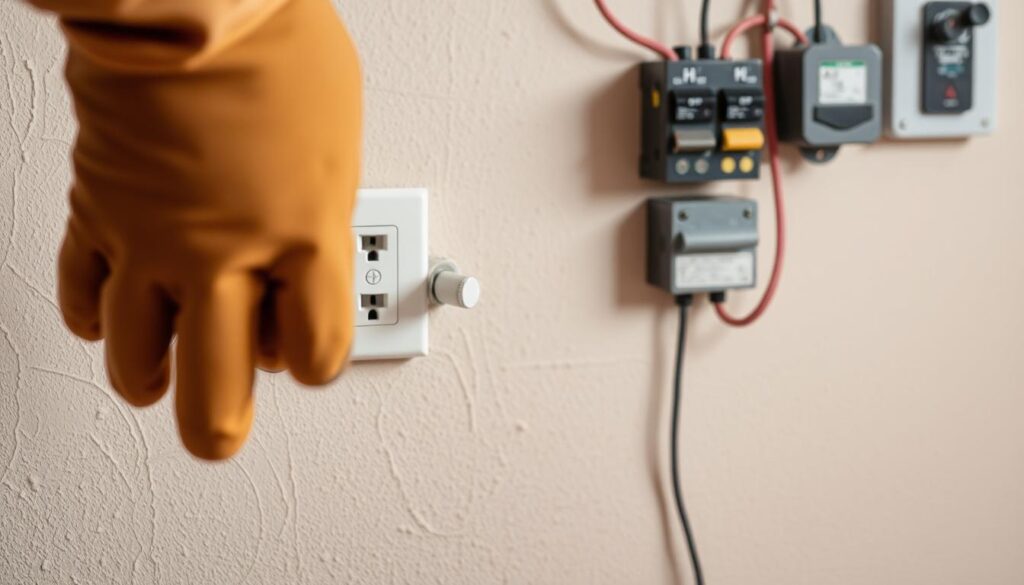
Electrical shocks are a serious safety hazard that homeowners should be aware of and know how to handle. Experiencing an electrical shock can be a frightening and potentially life-threatening situation. Understanding the proper steps to take in such an event is crucial for minimizing harm and ensuring safety.
What to Do if You Experience a Shock
If you experience an electrical shock, the first step is to disconnect the power source immediately. If you’re unable to do so, try to free yourself from the source of the shock without touching it directly. It’s essential to stay calm and act quickly to prevent further injury.
For more detailed guidance on handling electrical emergencies, you can refer to resources such as this guide on handling electrical emergencies.
Preventing Future Electrical Shocks
Preventing electrical shocks involves regular maintenance and inspection of your home’s electrical system. Here are some key steps to follow:
- Regularly inspect electrical cords and appliances for damage.
- Avoid overloading outlets and circuits.
- Ensure that all electrical work is performed by a licensed professional.
To further enhance safety, consider the following table outlining common causes of electrical shocks and their preventive measures:
| Cause | Prevention |
|---|---|
| Damaged Cords | Regular inspection and replacement |
| Overloaded Outlets | Use surge protectors and avoid overloading |
| Improper Grounding | Ensure proper grounding by a licensed electrician |
By understanding the risks associated with electrical shocks and taking proactive steps to prevent them, homeowners can significantly reduce the risk of electrical accidents. Regular maintenance, proper use of electrical appliances, and awareness of potential hazards are key to ensuring a safe electrical environment.
Assessing and Replacing Fuses
Fuse issues can lead to significant electrical problems, making it essential to know how to identify and replace them. Fuses are critical components of your home’s electrical system, designed to protect against overloads and short circuits.
Identifying Fuse Issues
To identify fuse issues, start by understanding the signs of a blown fuse. Common indicators include:
- Dim or flickering lights
- Devices not functioning properly
- A blown fuse indicator, if your fuse box is equipped with one
Inspect your fuse box regularly to catch any potential issues early. Using the right electrical repair tools for homeowners can make this task easier and safer.
Step-by-Step Fuse Replacement
Replacing a fuse involves a few straightforward steps:
- Turn off the main electrical power supply to ensure safety.
- Identify the blown fuse by inspecting the fuse box.
- Remove the blown fuse using a fuse puller, if available.
- Insert a new fuse of the correct amperage rating.
- Restore power and test the circuit.
It’s crucial to use the correct replacement fuse and follow safety guidelines to avoid electrical hazards. Homeowners should familiarize themselves with electrical repair tools and safety practices to perform this task effectively.
Repairing Wiring Issues
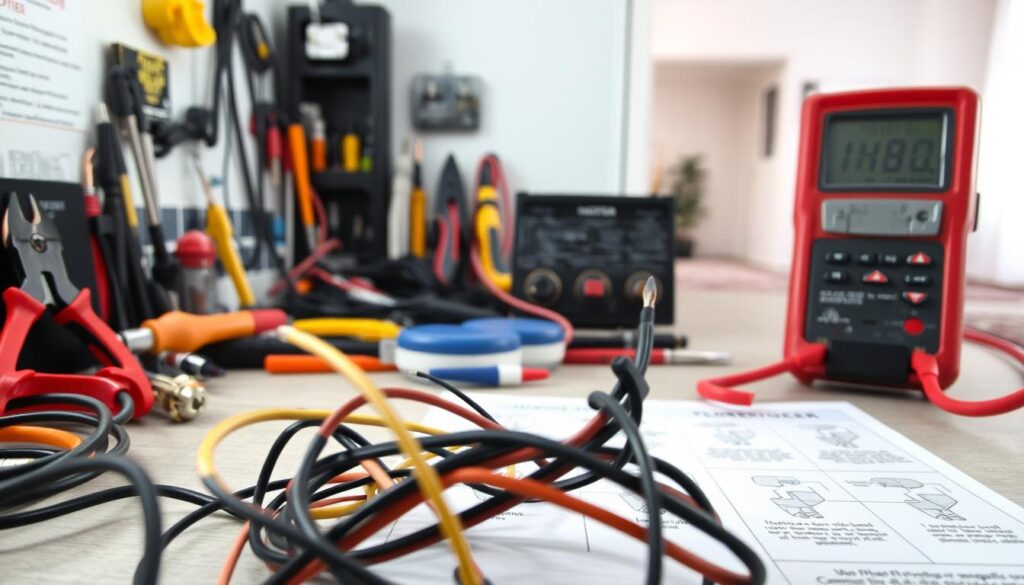
Identifying and fixing wiring issues is crucial for home electrical safety. Damaged or faulty wiring can lead to a range of problems, from minor inconveniences like flickering lights to serious safety hazards such as electrical fires.
Signs of Damaged Wiring
Recognizing the signs of damaged wiring is the first step towards easy electrical fixes for beginners. Common indicators include:
- Frequent tripping of circuit breakers
- Flickering or dimming lights
- Warm or discolored outlets and switches
- A burning smell from outlets or electrical devices
These signs suggest that your wiring may be compromised and requires immediate attention.
When to Call a Professional
While some wiring issues can be addressed with simple DIY fixes, others require the expertise of a licensed electrician. If you’re unsure about the severity of the problem or lack experience with electrical repairs, it’s best to seek professional help.
| Wiring Issue | DIY Fix | Professional Help |
|---|---|---|
| Loose connections | Yes, with proper tools | Recommended for safety |
| Damaged wiring | No, hazardous | Required |
| Outdated wiring | No, complex | Required for upgrade |
For easy electrical fixes for beginners, start by inspecting your wiring for visible signs of damage. However, always err on the side of caution and consult a professional if you’re in doubt.
Upgrading Outdated Electrical Systems
Modernizing your home’s electrical system is a vital step towards ensuring safety and efficiency. Outdated systems can lead to numerous issues, including increased risk of electrical fires and inefficiencies in power distribution.
Benefits of Modernizing Your System
Upgrading your electrical system can have several benefits. It enhances safety by reducing the risk of electrical shocks and fires. Modern systems are also more efficient, potentially lowering energy bills by ensuring that appliances and lighting operate effectively. For homeowners, understanding basic electrical repairs for homeowners is crucial in maintaining a safe and efficient home.
Moreover, a modernized electrical system can increase your home’s value. Potential buyers are more attracted to homes with updated electrical systems, as they signify less risk and lower maintenance costs in the long run.
Key Components to Upgrade
When considering an upgrade, several key components should be evaluated. These include:
- Circuit breakers and fuses
- Outlets and switches
- Wiring and electrical panels
For effective home electrical maintenance, it’s essential to assess these components regularly. Upgrading outdated or worn-out parts can significantly improve your home’s electrical infrastructure.
| Component | Benefits of Upgrade | Considerations |
|---|---|---|
| Circuit Breakers | Enhanced safety, reduced risk of overload | Compatibility with existing wiring |
| Outlets and Switches | Improved functionality, aesthetic appeal | Style and finish to match home decor |
| Wiring and Electrical Panels | Increased efficiency, safety | Professional assessment recommended |
For homeowners looking to upgrade their electrical systems, it’s advisable to consult with a professional to ensure compliance with local electrical codes and standards. You can find more information on electrical repairs and maintenance services at https://worldcivilsociety.com/24-7-construction-repair/.
Understanding Local Electrical Codes
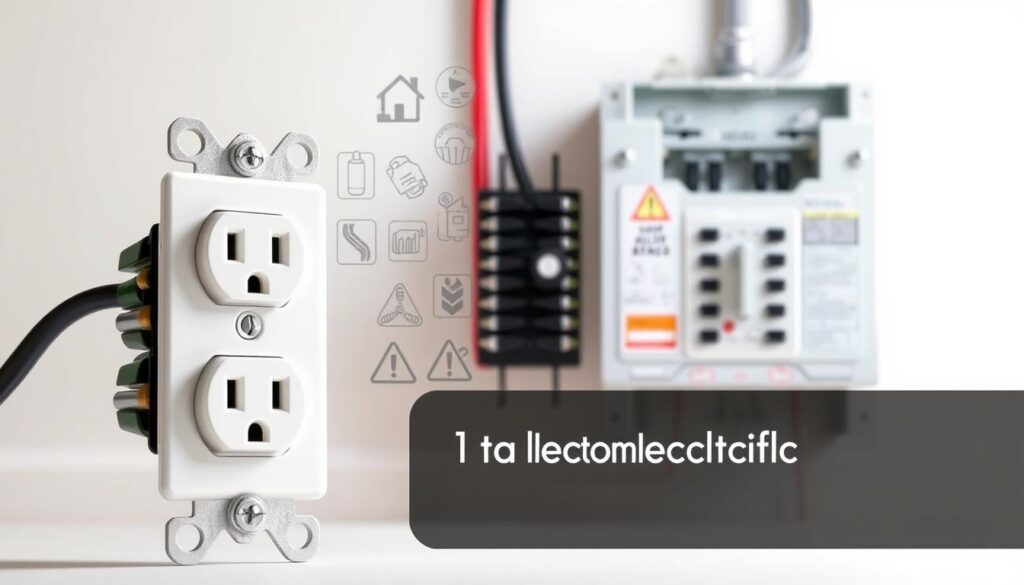
One of the most critical aspects of electrical safety is compliance with local electrical codes, which helps prevent electrical shocks and other hazards. Local electrical codes are regulations that govern the installation, maintenance, and operation of electrical systems within a specific geographic area.
Importance of Compliance
Compliance with local electrical codes is not just a legal requirement; it’s also crucial for ensuring electrical safety. By adhering to these codes, homeowners can significantly reduce the risk of electrical accidents, including shocks, fires, and other hazards. Non-compliance can lead to serious consequences, including fines and increased insurance premiums.
Local electrical codes are designed to protect both people and property. They cover a wide range of topics, from the type of wiring to be used to the safety standards for electrical appliances. Understanding these codes is essential for anyone undertaking electrical work, whether it’s a simple repair or a major installation.
Resources for Learning Local Codes
Fortunately, there are several resources available to help homeowners learn about local electrical codes. These include:
- Local government websites, which often provide detailed information on electrical codes and regulations.
- Professional electrical associations, which can offer guidance and resources on code compliance.
- Online databases and forums, where homeowners can ask questions and share experiences related to electrical codes.
For those new to electrical safety, understanding local electrical codes can seem daunting. However, by taking the time to learn about these regulations, homeowners can ensure their electrical systems are safe and compliant.
| Resource | Description | Benefit |
|---|---|---|
| Local Government Websites | Provide detailed information on electrical codes and regulations. | Official and authoritative source. |
| Professional Electrical Associations | Offer guidance and resources on code compliance. | Expert advice and support. |
| Online Databases and Forums | Allow homeowners to ask questions and share experiences. | Community support and real-world insights. |
Maintaining Electrical Safety in Your Home
To keep your home safe, it’s essential to understand the basics of electrical safety and how to maintain it effectively. Electrical safety is not just about fixing issues as they arise; it’s about taking proactive steps to prevent problems from occurring in the first place.
Regular Inspection Tips
Regular inspections are a critical component of maintaining electrical safety. Homeowners should periodically check their electrical systems for signs of wear or damage. This includes inspecting wiring for fraying or damage, checking outlets for signs of overheating, and ensuring that circuit breakers are functioning correctly.
When inspecting your home’s electrical system, it’s also important to look for signs of potential issues, such as flickering lights, warm outlets, or burning smells from electrical devices. These can be indicators of underlying problems that need to be addressed.
- Check for worn-out or damaged cords and replace them as needed.
- Ensure that all electrical outlets are properly grounded.
- Use electrical repair tools designed for homeowners, such as multimeters, to test for voltage and continuity.
When to Seek Professional Help
While many electrical issues can be resolved by homeowners, there are times when it’s necessary to seek professional help. If you’re unsure about how to troubleshoot an electrical issue or if the problem is beyond your skill level, it’s best to consult a licensed electrician.
Signs that you need professional assistance include frequent circuit breaker tripping, sparks from outlets, or a burning smell from electrical panels. These issues can indicate serious electrical problems that require immediate attention from a qualified professional.
By staying vigilant and performing regular inspections, homeowners can significantly reduce the risk of electrical accidents. Remember, electrical safety is an ongoing process that requires attention and maintenance over time.
Conclusion: Empowering Homeowners with Electrical Knowledge
By understanding the basics of electrical systems and following simple DIY electrical repair tips, homeowners can tackle common electrical issues with confidence. Easy electrical fixes for beginners can be a great starting point for those looking to take control of their home’s electrical maintenance.
Key Takeaways
The key points covered in this article provide a comprehensive guide to identifying and resolving common electrical problems. From troubleshooting flickering lights to addressing overloaded circuits, homeowners can now approach electrical repairs with a newfound sense of confidence.
Empowering DIY Repairs
With the knowledge gained from this article, homeowners can perform easy electrical fixes and DIY repairs, reducing the need for costly professional services. By taking an active role in maintaining their electrical systems, homeowners can ensure their safety and the overall efficiency of their home’s electrical infrastructure.
